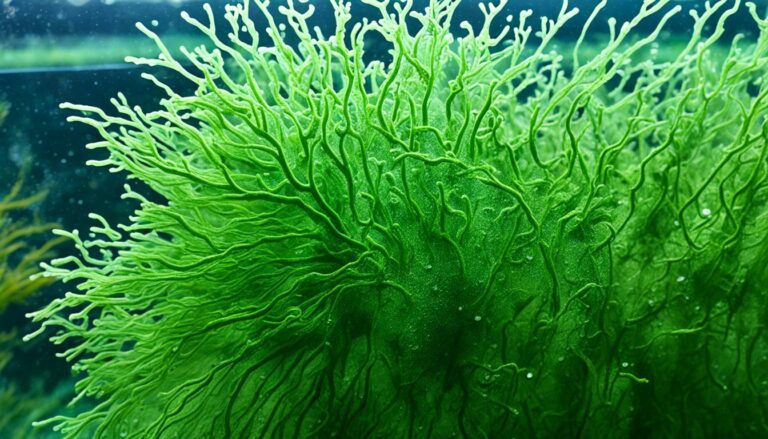Welcome to the world of aquarium maintenance. We’ll explore the issue of brown algae together. It’s common for tanks to suddenly show brown patches. I’ve faced this too, seeing my clear tank turn into a diatom fest. These brown algae are common in new aquariums. Yet, understanding algae bloom prevention helps beat this challenge.
Did you know brown algae comes from billions of tiny creatures called diatoms in aquariums? They aren’t true algae but single-celled beings. Early in a tank’s life, they thrive on nitrates and phosphates. This happens as waste breaks down, feeding them.
But there’s hope! Proper filtration and careful aquarium maintenance lower the risk of brown algae. Limit phosphates and nitrates. How? By changing water often and not overfeeding fish. Also, clean your tank’s glass properly. And gently clean the gravel to protect good bacteria.
With some knowledge and effort, you can stop brown algae. Let me show you how to keep your aquarium clear and healthy. Follow along for tips on fighting algae and maintaining a thriving tank.
An Introduction to Brown Algae in Aquariums
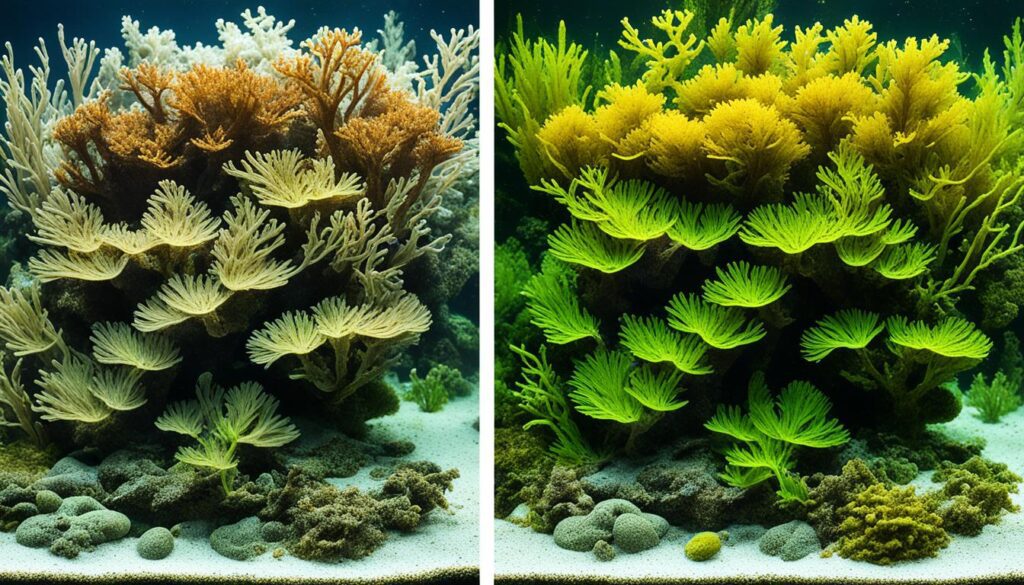
Setting up a new aquarium often brings a challenge: brown algae. Knowing about brown algae identification is key to good tank maintenance. Knowledge of diatom characteristics and aquarium algae types helps even beginners maintain a healthy aquarium.
Defining Brown Algae and Its Characteristics
Brown algae consist of diatoms, creating a slimy, brown layer on everything in the tank. Contrary to popular belief, diatoms are microalgae, not true algae, needing silica to thrive. They usually increase in new tanks due to high silicate in tap water. A helpful guide on tackling aquarium algae is found on managing algae in fish tanks.
Distinguishing Between Diatoms and True Algae
Diatoms and true algae both live in tank ecosystems, but they’re different. Diatoms, or “brown algae,” need silica for growth, unlike true algae. Knowing this is vital for controlling them in tanks. Cutting their numbers involves regular water changes and light control.
For more on diatom characteristics and setting them apart from other aquarium algae types, see this table:
Characteristic |
Diatoms (“Brown Algae”) |
True Algae |
|---|---|---|
Cell Composition |
Single-celled, with silica walls |
Multi-celled, without silica dependency |
Appearance in Tank |
Dark, slimy coating |
Green, stringy or bushy forms |
Nutrient Requirements |
High silicates |
Primarily phosphates & nitrates |
Common Solutions |
Use of snails, shrimp; silica reduction |
Algae eating fish; light regulation |
Dealing with brown algae, or diatoms, is often the first step for aquarium enthusiasts. Recognizing diatom characteristics and knowing aquarium algae types helps keep your tank beautiful and healthy. Success comes from early brown algae identification and specific actions to maintain ideal conditions for tank life.
Understanding the Root Causes of Brown Algae
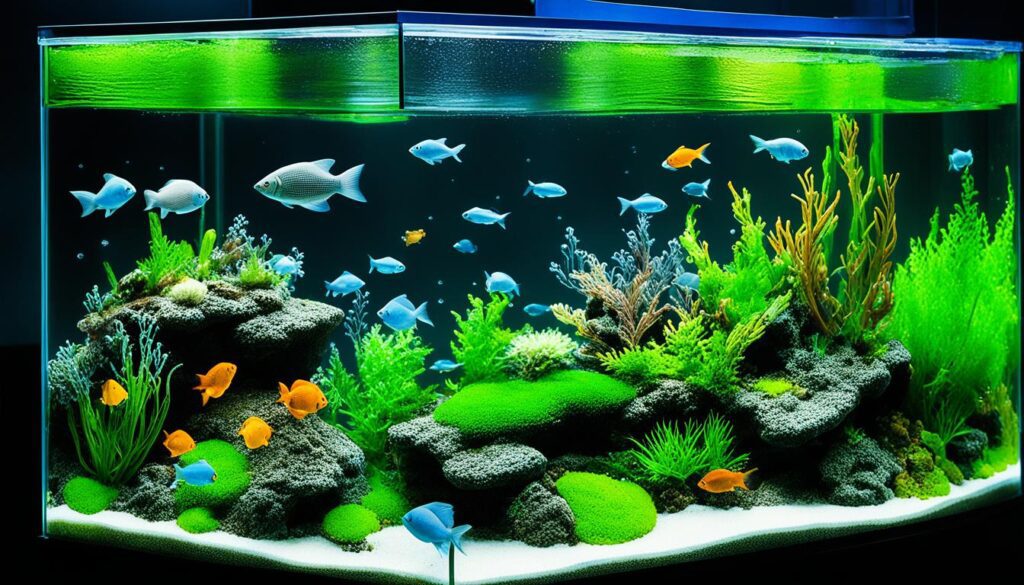
Many aquarium lovers find brown algae, also known as diatoms, a big problem. Why do these diatoms thrive in home aquariums? Let’s look closer at reasons like aquarium cycling, extra nutrients in tanks, and silica effects.
The Role of Excess Nutrients in Algae Growth
Nitrates and phosphates rise because of organic waste. This includes waste from fish, dead plants, and leftover food. This nutrient excess in tanks makes a perfect environment for brown algae. Diatoms feed on these nutrients, which often pile up when you first set up a tank. For more details, check this guide on brown algae.
Aquarium Cycling and Its Impact on Algae Bloom
Setting up a new tank involves a crucial step called aquarium cycling. This process helps good bacteria grow. These bacteria break down toxic ammonia and nitrite into safer nitrates. But, in the beginning, changing compound levels can boost diatom growth. This is seen as a brown layer on new stuff in the tank.
How Silica Contributes to Diatom Proliferation
Diatoms need silica for their cell walls. Tap or well water can have a lot of silica, helping diatoms grow in your tank. Handling silica levels and doing regular tank upkeep can help a lot with this problem.
To fight brown algae, tackle the main causes: too many nutrients, poor aquarium cycling, and high silica. Improving the look and health of your tank is possible. Regularly change the water, clean the substrate, and maybe add algae-eating fish and snails. This can help keep your aquarium clean and healthy.
The Effects of Brown Algae on Aquarium Health
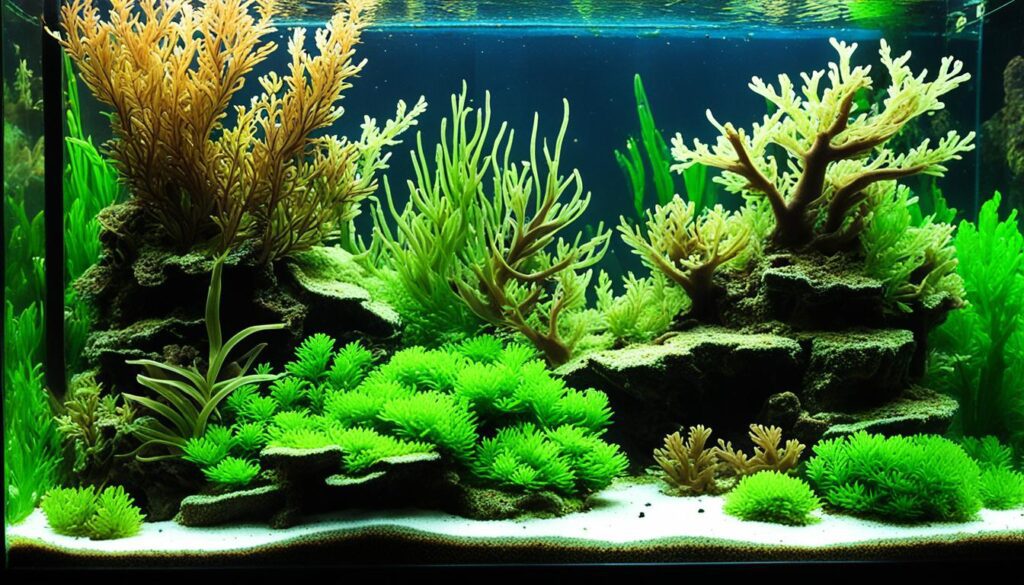
For anyone setting up an aquarium, keeping it healthy is key. Brown algae, or diatom algae, is a big worry because it can hurt aquarium health. It’s not all bad for fish, as some even eat it. But, the problems it causes for aquatic plants and the tank’s ecosystem are too big to ignore.
A healthy aquarium needs plant photosynthesis. It gives oxygen to fish and other water life. But, brown algae can cover plants and decorations, stopping photosynthesis. This lack of light harms plant health and could lead to their death if not taken care of.
To keep your aquarium healthy, taking good care and doing regular clean-ups are necessary. Managing brown algae is important. Below, you’ll find statistics and advice on handling different types of algae, including brown algae:
Algae Type |
Characteristics |
Control Measures |
|---|---|---|
Brown Algae (Diatoms) |
Grows in low light, common in new tanks |
Regular cleaning, light control |
Black Beard Algae (BBA) |
Tough, coats decorations, likes strong flow |
Use Siamese algae eaters, more CO2, adjust flow |
Green Spot Algae (GSA) |
Forms on slow plants, needs balance |
Keep nutrients balanced, add CO2 |
Blue-Green Algae (BGA) |
Slippery, covers tank |
Use Erythromycin, clean carefully |
By looking at these algae types, we see the importance of balance in light, nutrients, and cleanliness. It helps plant photosynthesis and improves aquarium health.
Keeping up with your aquarium can lessen algae problems. It makes the aquarium healthier for plants and fish. It also looks better.
Proven Techniques for Removing Brown Algae
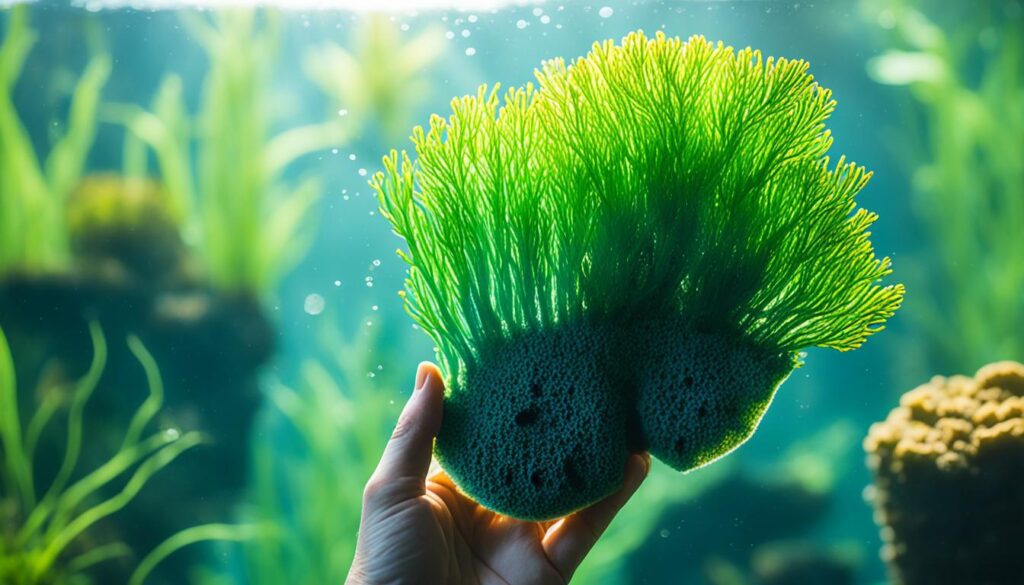
Getting rid of brown algae is about more than cleaning. It involves understanding the right way to clean and using the natural eating habits of certain fish and snails. We will look at how mechanical and biological ways can help keep your tank clear.
Cleaning Strategies for Various Aquarium Surfaces
Removing brown algae usually starts with manual cleaning. For glass, use scrapers, sponges, or magnetic tools. Be gentle to avoid scratches but make sure to get all the algae off.
For plant leaves, gently wipe with a soft, wet cloth. This keeps the plants safe from harm. For decorations and tough spots, use toothbrushes or wire brushes. After getting rid of the algae, vacuum the gravel well. This step takes out any leftover algae pieces, stopping them from growing back.
Cleaning methods may change depending on your tank’s needs. If algae come back fast, test the water. You might need to fix nutrient levels or cut down on light. Less light means less algae growth.
The Role of Algae-Eating Species in Control
Adding algae-eaters to your tank helps control brown algae naturally. Fish like Bristlenose Plecos and Otocinclus Catfish are great at this. So are Nerite Snails and Amano Shrimp. They all have a special skill in reducing algae.
Nerite Snails are good at cleaning glass and decorations. Amano Shrimp get into small spaces, cleaning areas big fish can’t. But make sure any new fish or snails fit well with those already in your tank. And remember, they help but aren’t the only solution to algae problems.
Keeping your water balanced is key to stopping algae from coming back. Keep your tank clean and think about adding algae-eating fish or snails. This way, you’ll have a tank that’s not just clear but also healthy.
Preventative Measures Against Brown Algae
Keeping an aquarium clean is a dream for many enthusiasts. Brown algae can be a big issue, especially in the beginning. It’s best to stop problems before they start. Changing 50% of the water every week helps avoid these algae. This lets good bacteria grow and keeps nutrients low.
Adding plants to your tank fights off brown algae too. They use up nutrients, leaving less for the algae. Make sure your tank’s water flows well, about 10 times its volume. This keeps the water oxygen-rich and stops algae from taking over. Agitating the surface also helps by preventing scum and keeping oxygen steady.
Feeding fish too much causes issues. Unused food increases nitrates and phosphates, which algae love. To prevent this, feed your fish small amounts and keep the water moving. Lighting for 6-8 hours a day supports plants over algae. Regular cleaning of the substrate and filter is crucial. It keeps the tank’s ecosystem balanced and clean.
